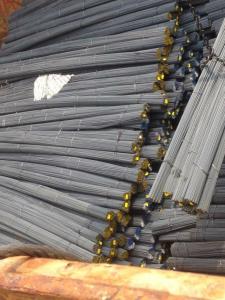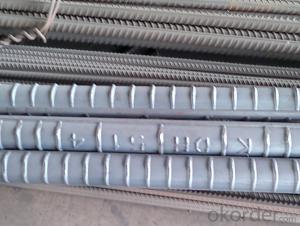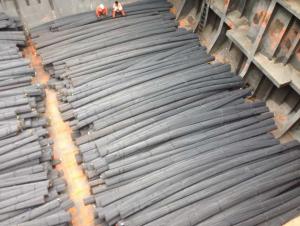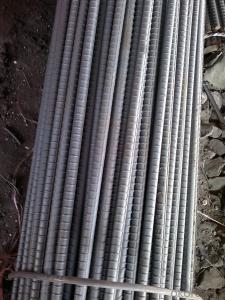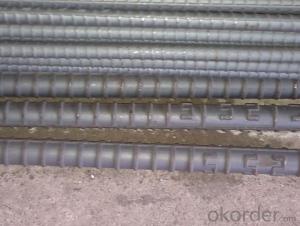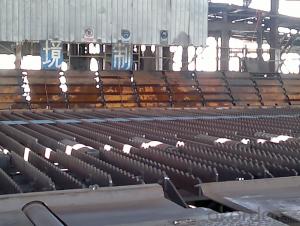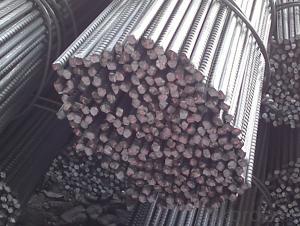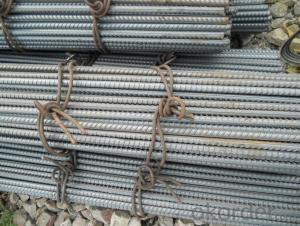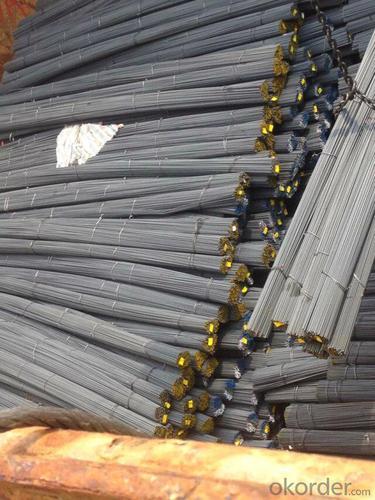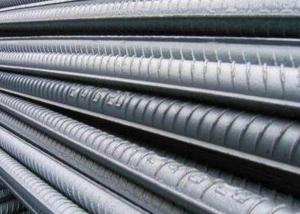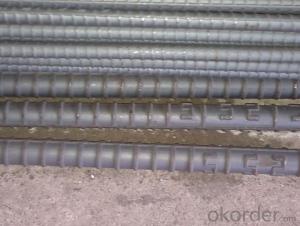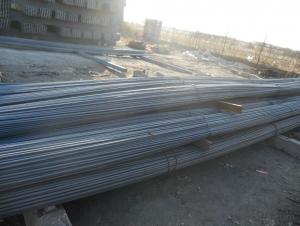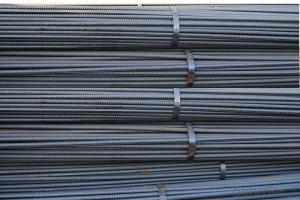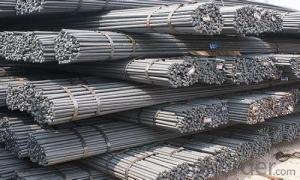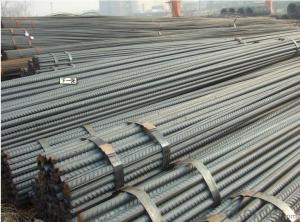Deformed Steel Bar HRB400
- Loading Port:
- China Main Port
- Payment Terms:
- TT or LC
- Min Order Qty:
- -
- Supply Capability:
- -
OKorder Service Pledge
OKorder Financial Service
You Might Also Like
Product Description:
OKorder is offering Deformed Steel Bar HRB400 at great prices with worldwide shipping. Our supplier is a world-class manufacturer of steel, with our products utilized the world over. OKorder annually supplies products to European, North American and Asian markets. We provide quotations within 24 hours of receiving an inquiry and guarantee competitive prices.
Standard | GB | HRB400 | |
Diameter | 6mm,8mm,10mm,12mm,14mm,16mm,18mm,20mm, 22mm,25mm,28mm,32mm,36mm,40mm,50mm | ||
Length | 6M, 9M,12M or as required | ||
Place of origin | Hebei, China mainland | ||
Advantages | exact size, regular package, chemical and mechanical properties are stable. | ||
Type | Hot rolled deformed steel bar | ||
Brand name | DRAGON | ||
Chemical Composition: (Please kindly find our chemistry of our material based on HRB500 as below for your information)
Grade | Technical data of the original chemical composition (%) | ||||||
C | Mn | Si | S | P | V | ||
HRB400 | ≤0.25 | ≤1.60 | ≤0.80 | ≤0.045 | ≤0.045 | 0.04-0.12 | |
Physical capability | |||||||
Yield Strength (N/cm²) | Tensile Strength (N/cm²) | Elongation (%) | |||||
≥400 | ≥570 | ≥14 | |||||
Theoretical weight and section area of each diameter as below for your information:
Diameter(mm) | Section area (mm²) | Mass(kg/m) | Weight of 12m bar(kg) |
6 | 28.27 | 0.222 | 2.664 |
8 | 50.27 | 0.395 | 4.74 |
10 | 78.54 | 0.617 | 7.404 |
12 | 113.1 | 0.888 | 10.656 |
14 | 153.9 | 1.21 | 14.52 |
16 | 201.1 | 1.58 | 18.96 |
18 | 254.5 | 2.00 | 24 |
20 | 314.2 | 2.47 | 29.64 |
22 | 380.1 | 2.98 | 35.76 |
25 | 490.9 | 3.85 | 46.2 |
28 | 615.8 | 4.83 | 57.96 |
32 | 804.2 | 6.31 | 75.72 |
36 | 1018 | 7.99 | 98.88 |
40 | 1257 | 9.87 | 118.44 |
50 | 1964 | 15.42 | 185.04 |
Deformed bar is widely used in buildings, bridges, roads and other engineering construction. Big to highways, railways, bridges, culverts, tunnels, public facilities such as flood control, dam, small to housing construction, beam, column, wall and the foundation of the plate, deformed bar is an integral structure material. With the development of world economy and the vigorous development of infrastructure construction, real estate, the demand for deformed bar will be larger and larger..
Packaging Detail: products are packed in bundle and then shipped by container or bulk vessel, deformed bar is usually naked strapping delivery, when storing, please pay attention to moisture proof. The performance of rust will produce adverse effect.
Each bundle weight: 2-3MT, or as required
Product Applications:
Deformed Steel Bar HRB400 are ideal for structural applications and are widely used in the construction of buildings and bridges, and the manufacturing, petrochemical, and transportation industries.
Product Advantages:
OKorder's Deformed Steel Bar HRB400 are durable, strong, and resist corrosion.
Main Product Features:
· Premium quality
· Prompt delivery & seaworthy packing (30 days after receiving deposit)
· Corrosion resistance
· Can be recycled and reused
· Mill test certification
Product Specifications:
Standard: GB
Material: Q235
Origin place: China
FAQ:
Q1: Can stainless steel rust?
A1: Stainless does not "rust" as you think of regular steel rusting with a red oxide on the surface that flakes off. If you see red rust it is probably due to some iron particles that have contaminated the surface of the stainless steel and it is these iron particles that are rusting. Look at the source of the rusting and see if you can remove it from the surface.
Q2: How do we guarantee the quality of our products?
A2: We have established an advanced quality management system which conducts strict quality tests at every step, from raw materials to the final product. At the same time, we provide extensive follow-up service assurances as required.
Q3: How soon can we receive the product after purchase?
A3: Within three days of placing an order, we will begin production. The specific shipping date is dependent upon international and government factors, but is typically 7 to 10 workdays.
bdenum enhance this surface layer and improve the corrosion resistance of the stainless material.
Images:
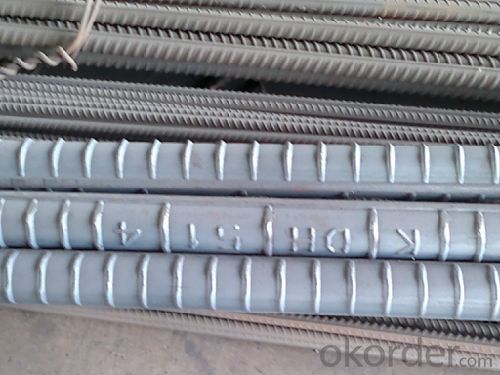
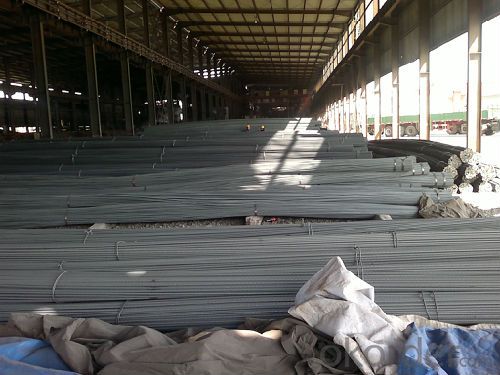
- Q: What is the best way to store steel rebars on site?
- The best way to store steel rebars on site is to stack them off the ground on a flat, level surface. They should be stored in an upright position, vertically aligned, and separated by appropriate spacers to prevent any contact or tangling. Additionally, covering them with a protective tarp or material can help shield them from moisture and other elements that may cause corrosion.
- Q: Can steel rebars be used in the construction of residential communities?
- Yes, steel rebars can be used in the construction of residential communities. Steel rebars provide strength and durability to reinforced concrete structures, making them suitable for a wide range of construction projects, including residential buildings. The use of steel rebars helps ensure the structural integrity and longevity of the buildings, making them a reliable choice for residential communities.
- Q: What are the different methods of joining steel rebars?
- There are several methods of joining steel rebars, each with its own advantages and disadvantages. Here are the most common methods: 1. Lap Splicing: This is the most common method of joining rebars. In lap splicing, two rebars are overlapped and tied together using wire or metal ties. This method is simple and cost-effective, but it requires longer lap lengths to achieve the required strength. 2. Mechanical Splicing: Mechanical splicing involves joining rebars using mechanical couplers or splices. These couplers are designed to provide a strong and reliable connection between the rebars. Mechanical splicing offers quicker installation and reduces the need for lap lengths. However, it may be more expensive than lap splicing. 3. Welding: Welding is another method of joining steel rebars. In this process, the rebars are heated and fused together using electric arcs or gas flames. Welding provides a strong and permanent connection, but it requires skilled labor and specialized equipment. It is commonly used in precast concrete applications. 4. Bolted Connections: Bolted connections involve using bolts and nuts to connect the rebars. This method provides a flexible and adjustable connection, making it suitable for certain applications. However, bolted connections require additional hardware and may not be as strong as other methods. 5. Adhesive Bonding: Adhesive bonding involves using epoxy or other adhesives to join rebars. The adhesive is applied to the rebars, and they are pressed together until the adhesive cures and forms a strong bond. Adhesive bonding offers a clean and aesthetically pleasing finish, but it may not be as strong as other methods and is more suitable for non-structural applications. It is important to note that the choice of joining method depends on factors such as the specific project requirements, structural design, and construction techniques. Consulting with structural engineers and following industry standards and codes is crucial to ensure the proper selection and implementation of the joining method for steel rebars.
- Q: Are there any standards or codes for steel rebars?
- Yes, there are various standards and codes that govern the manufacturing, testing, and use of steel rebars. These standards typically include specifications for the chemical composition, mechanical properties, dimensions, and tolerances of rebars. Some commonly recognized standards and codes for steel rebars include ASTM A615/A615M, ASTM A706/A706M, and BS 4449. Compliance with these standards ensures the quality and safety of steel rebars used in construction projects.
- Q: How do steel rebars impact the overall construction timeline?
- Steel rebars play a crucial role in the overall construction timeline as they significantly impact the speed and efficiency of the construction process. The use of steel rebars helps in reinforcing the concrete structures, providing strength, durability, and resistance to the overall construction project. Firstly, steel rebars enable faster construction by reducing the curing time of concrete. When embedded within the concrete, rebars help to distribute the load evenly, making the structure stronger and allowing for quicker construction. This is especially important in high-rise buildings or large-scale projects where time is of the essence. Moreover, steel rebars enhance the structural integrity of the construction, ensuring that it can withstand various forces such as earthquakes, wind, and heavy loads. By reinforcing the concrete, rebars prevent cracks and failures, enhancing the longevity and safety of the building. This reduces the need for costly repairs or renovations in the future, thereby saving time in the long run. Additionally, the use of steel rebars allows for flexibility in design and construction. With rebars, architects and engineers can create complex structures, such as curved or irregular shapes, without compromising on strength or stability. This versatility reduces the time required for design modifications and construction alterations, enabling a faster overall timeline. Furthermore, steel rebars are readily available in the market and are manufactured to meet specific industry standards. This ensures a consistent supply of high-quality materials, reducing delays caused by material shortages or quality issues. Contractors can easily procure rebars, allowing for a smooth workflow and timely completion of the construction project. In conclusion, steel rebars have a significant impact on the overall construction timeline. They accelerate the construction process, increase the structural integrity, allow for design flexibility, and ensure a consistent supply of materials. By incorporating steel rebars into construction projects, contractors can save time, reduce potential setbacks, and deliver projects within the desired timeframe.
- Q: How are steel rebars used in the construction of power transmission towers?
- To reinforce and strengthen power transmission towers, steel rebars are commonly utilized in their construction. These rebars, typically crafted from high-strength steel, find application in various tower components such as the foundation, columns, and cross arms. To bolster the load-bearing capacity of the foundation, steel rebars are embedded in concrete. By distributing the weight of the tower and transmission lines, these rebars maintain the stability of the foundation and enable it to endure the exerted forces. Within the tower columns, steel rebars are employed to fortify the concrete structure, enhancing its strength and stability. Given that power transmission towers are often exposed to strong winds, seismic activities, and other external forces, the presence of rebars prevents the concrete from experiencing cracks or collapses. This ensures the tower's integrity and longevity. Additionally, steel rebars are utilized in the construction of cross arms, which provide horizontal support to the transmission lines. By reinforcing the cross arms, these rebars enable them to effectively bear the weight of the lines. This is particularly crucial since power transmission lines can span long distances and carry significant loads. To summarize, the utilization of steel rebars is crucial in the construction of power transmission towers as they provide the necessary strength and reinforcement to ensure the tower's stability and durability. The absence of these rebars would render the towers more vulnerable to structural failures, posing risks to the transmission lines and surrounding areas.
- Q: What are the different types of steel rebars used in earthquake-prone regions?
- In earthquake-prone regions, various types of steel rebars are used to enhance the structural integrity and resilience of buildings. These rebars are specifically designed to withstand the powerful forces generated during seismic events, thus reducing the risk of structural failure. The different types of steel rebars commonly used in earthquake-prone regions include: 1. Mild Steel Rebars (MSR): These rebars, also known as carbon steel rebars, are the most commonly used type due to their affordability and availability. MSR rebars have a relatively low yield strength, typically ranging from 250 to 420 megapascals (MPa). While they provide basic reinforcement, they are not specifically designed to withstand intense seismic forces. 2. High-Strength Deformed Bars (HSD): HSD rebars have significantly higher yield strength compared to MSR rebars, typically ranging from 415 to 600 MPa. These rebars are manufactured by subjecting carbon steel to additional heat treatment and controlled cooling, resulting in improved strength and ductility. HSD rebars are more resistant to seismic forces and are commonly used in earthquake-prone regions. 3. Stainless Steel Rebars (SSR): Stainless steel rebars are highly resistant to corrosion and possess excellent strength characteristics. They are commonly used in coastal earthquake-prone regions where exposure to saltwater or corrosive environments is a concern. SSR rebars provide enhanced durability and longevity, reducing the risk of structural damage caused by corrosion over time. 4. Fiberglass Rebars: Fiberglass rebars, also known as FRP (fiber-reinforced polymer) rebars, are non-metallic reinforcement alternatives gaining popularity in earthquake-prone regions. Made from glass fibers embedded in a polymer resin matrix, FRP rebars offer excellent resistance to corrosion, making them suitable for coastal regions. Although they have lower strength compared to steel rebars, FRP rebars have high tensile strength, making them a viable option for seismic reinforcement. 5. Galvanized Rebars: Galvanized rebars are carbon steel rebars coated with a layer of zinc to enhance corrosion resistance. The zinc coating acts as a sacrificial layer, protecting the underlying steel from corrosion. While galvanized rebars are not specifically designed for seismic resistance, they offer improved durability in earthquake-prone regions with high moisture or corrosive conditions. It is important to note that the selection of steel rebars in earthquake-prone regions depends on various factors, including the level of seismic activity, building codes and regulations, budget constraints, and specific project requirements. Consulting with structural engineers and adhering to local building codes is crucial in determining the appropriate type of steel rebars for seismic reinforcement to ensure the safety and resilience of structures in these regions.
- Q: Can steel rebars be used in modular bridges?
- Yes, steel rebars can be used in modular bridges. Steel rebars are commonly used in the construction of bridges due to their strength, durability, and ability to handle heavy loads. They provide reinforcement to the concrete components of the bridge, ensuring its structural integrity. In modular bridge construction, steel rebars are often incorporated into precast concrete elements, allowing for efficient and cost-effective assembly of the bridge modules.
- Q: Are there any specific safety precautions to be taken while handling steel rebars?
- Yes, there are specific safety precautions to be taken while handling steel rebars. Some of these precautions include wearing appropriate personal protective equipment (PPE) such as gloves, safety boots, and eye protection to prevent injuries. It is also important to ensure a safe lifting technique while handling heavy rebars to avoid strains or back injuries. Additionally, workers should be cautious of sharp ends of the rebars and use caution to avoid any cuts or punctures. Regular inspection and maintenance of the rebars is essential to identify any damages or defects that could compromise safety.
- Q: How do steel rebars impact the overall flexibility of a structure?
- Steel rebars, also known as reinforcing bars, play a crucial role in enhancing the overall flexibility of a structure. These bars are typically used in reinforced concrete structures to provide tensile strength and improve the structural integrity of the building. The incorporation of steel rebars in concrete significantly increases the flexibility of a structure. Concrete itself is strong in compression but weak in tension. By integrating rebars, the structure becomes more capable of withstanding tensile forces and resisting bending or deformation caused by external loads or environmental factors. The rebars act as reinforcement by absorbing and distributing tensile forces throughout the structure, helping to prevent cracks and ensuring a more even distribution of stress. This is particularly important in areas prone to seismic activity or high wind loads, where structures need to be able to flex and absorb the energy exerted on them. Moreover, the presence of steel rebars also allows for the creation of thinner and lighter concrete sections. This contributes to the overall flexibility of the structure by reducing the dead load, making it more responsive and adaptable to different conditions. In summary, steel rebars greatly impact the overall flexibility of a structure by providing tensile strength, preventing cracks, distributing stress, and allowing for lighter and thinner concrete sections. By enhancing the structural integrity and resilience, the inclusion of rebars ensures that the building can withstand external forces while maintaining its stability and flexibility, ultimately contributing to its longevity and safety.
Send your message to us
Deformed Steel Bar HRB400
- Loading Port:
- China Main Port
- Payment Terms:
- TT or LC
- Min Order Qty:
- -
- Supply Capability:
- -
OKorder Service Pledge
OKorder Financial Service
Similar products
Hot products
Hot Searches
Related keywords
